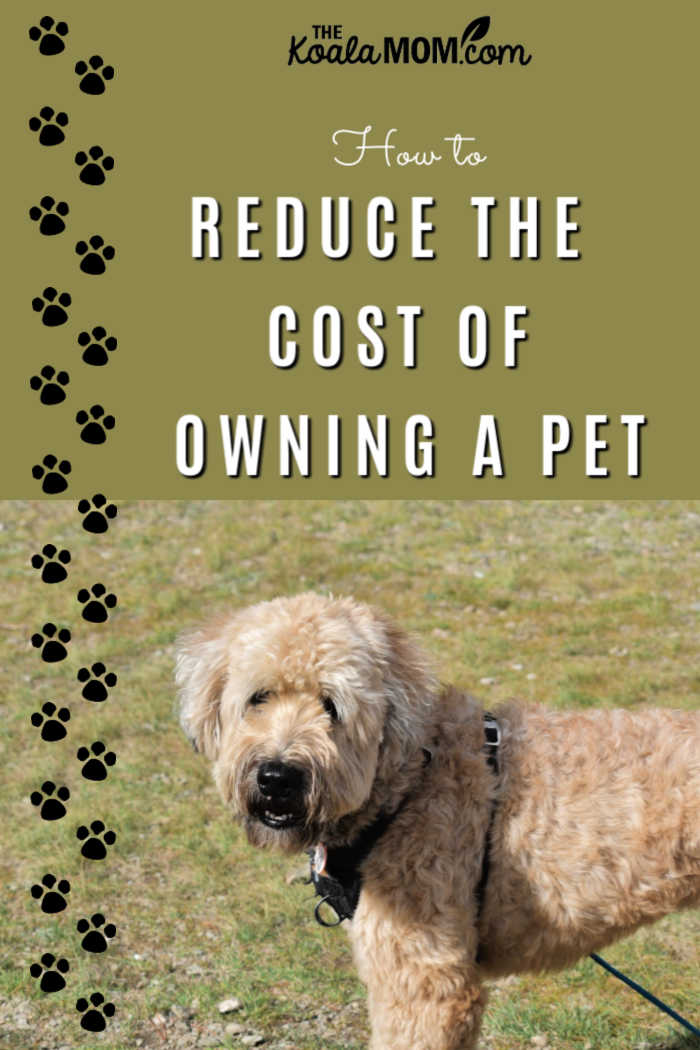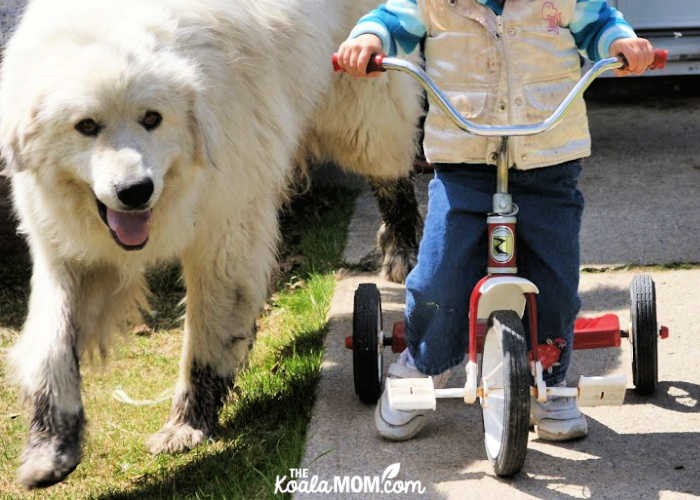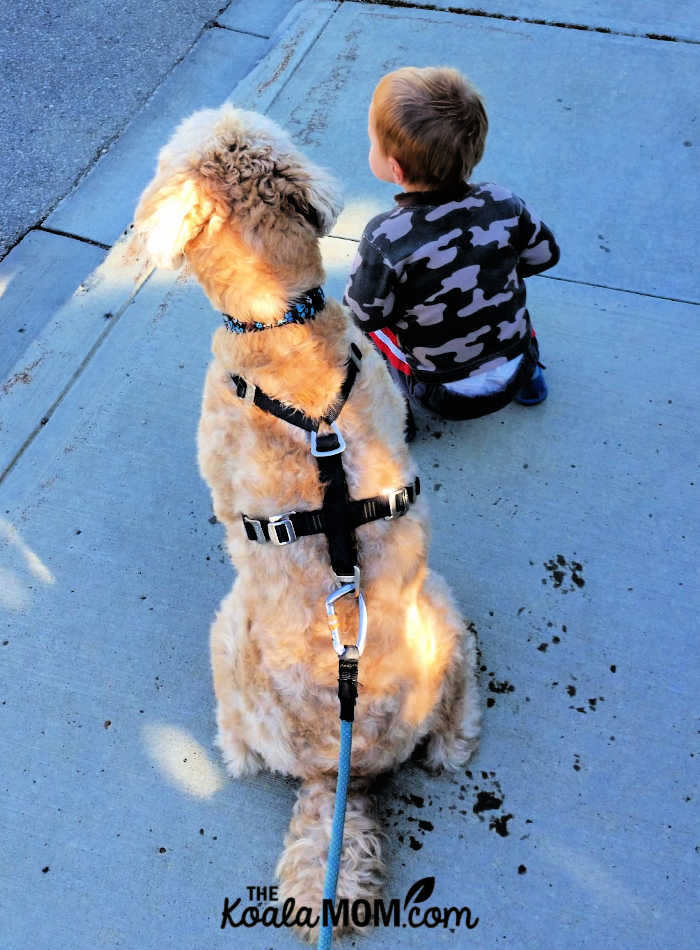We talk frequently about getting a dog for our kids, and the pros and cons of that, and what’s the best breed, and more. Cost has come up in our discussions more than once, as pets cost more than just the initial price to purchase them. This post goes over some of the common expenses of pet owners and ways to reduce the cost of owning a pet.
Do you own a pet? Are you considering purchasing or adopting a pet? If the answer to either of those questions is yes, then you know that living with pets is one of those most rewarding experiences in life. Unfortunately, you also know that taking care of a pet can be ridiculously expensive. Here are four ways you can cut the cost of owning a dog or cat.

This is a guest post written for the Koala Mom. This post contains affiliate links; as an Amazon associate, I earn from qualifying purchases.
Owning a furry friend can cost you $125 – $824 monthly on average. With the average lifespan of a common household animal ranging from 5-15 years, that cost can add up quickly. However, there are cost-cutting options available to pet owners. By making some simple adjustments, you can enjoy the company of a four-legged friend without breaking the bank.
1. Pet Health Care
Medical care is the most expensive factor to consider when planning to bring a new friend into your home. Dogs and cats require several initial medical procedures to ensure their safety. Vaccines, spaying/neutering, and heartworm/flea prevention are all required when you first adopt or buy a pet. Some shelters or breeders will provide those services for you, but in other cases, you may have that responsibility. Without these procedures, you expose your pet to health risks like rabies and heartworms.
Luckily, you don’t have to go to an expensive vet to get these procedures. A multitude of animal welfare organizations exist that perform low-cost procedures, administer free shots, and even provide lower-cost veterinary care than a typical clinic. In the U.S., the Humane Society offers a list of organizations by state, so you can browse and find a clinic near you that offers the medical care you need, all for a cost that won’t leave you broke. The BC SPCA has a list of low-cost spay/neuter programs.
It’s also a good idea to get pet health insurance to help cover the cost of veterinarian bills.
2. Pet Weight Gain
Speaking of medical care, after the initial cost of vaccines and neutering, your pet will still be at risk for some common ailments. Obesity is a condition that can cause several other disorders if you’re not careful. Currently, 60% of cats and 56% of dogs are classified as overweight, making your new pet high risk for overeating and weight gain.
Preventing obesity and the issues that accompany it can help you reduce the cost of owning a pet. Keeping your pet as healthy as possible keeps them out of a vet’s office, which means they live longer, feel better, and cost much less. My best friend got a bassette hound when we were teenagers. Bassettes are notorious for being overweight, but my friend carefully monitored her hound’s food and the hound remained a trim little bassette all her life.
Feeding your pets great food doesn’t have to cost an arm and a leg either: most big box stores carry healthier pet food at similar prices to high-sodium and calorie pet food. In addition, you can do some online shopping at Pet Life to get high-quality food at much lower prices. Make sure that you follow portion recommendations for your animal’s weight and size in addition to lots of play, and they should feel much better in the long run.

3. Dog Grooming
Grooming is another expense you might not consider upon adopting a pet. Luckily, cats keep themselves pretty clean (although they still might require a bath or a trim, depending on their breed), but dogs are the main culprits of mangy, dirty fur and nails. Groomers can charge pretty high prices for their services, but you can reduce the cost of owning a pet by doing the grooming yourself.
If that sounds intimidating, don’t worry. The internet is a huge and wonderful mass of knowledge, offering big guides and videos on how to keep your dog or cat’s fur looking fresh. Bathing is as simple as washing your pet with sensitive soap in warm water. For actual grooming, all you really need is a set of pet grooming scissors, electric dog trimmers and maybe a cute outfit, and your pet will look fresh out of the salon for a way lower cost.
Here are some tips to remember when creating your own pet salon:
- Brushing regularly will often avoid matting fur, which makes trimming much easier. This is a great activity for kids to do with the dog!
- Protect your animal’s eyes while bathing. Have your partner or the kids hold the dog’s head and pet it during the bath.
- Have treats and a friend available to hold your pet still while trimming. Noises from an electric razor can be frightening.
- Be careful with scissors, as it is easier to nick sensitive skin if you don’t keep them level while trimming fur.
- Look up reference photos for your breed to follow.
Make sure to start a grooming routine for your pet as soon as you get it. Puppies and kittens are easy-going and small, and will soon get used to being brushed and having their toenails trimmed. Older dogs (or rescue dogs) may resist this more, requiring trips to a professional groomer.

4. Dog Treats
Committing to a pet also means committing to training said pet. Dogs especially require extensive training in terms of manners, playing with other dogs, and common commands. When you first go out on a walk with a new friend, pulling on the leash, barking at other dogs, and ignoring unknown commands will likely be your experience. If you have a new cat, they may feel the need to scratch up your new couch or leave a hairy present on your pillow.
The best way to avoid misbehavior from your pet is with positive reinforcement. By encouraging the behavior you do want, your pet will associate feeling good and treats with good behavior, making them more likely to act the way you want.
One of the most common forms of positive reinforcement is with treats. Food is the easiest gateway into your pet’s heart, but continually buying expensive treats for training or as a gift can really add up. Generally, treats are more expensive than regular pet food per ounce, and regular kibbles ‘n’ bits don’t appeal as much as a special treat to an animal.
Luckily, you can make your own dog treats at home. DIY treats are less processed, less expensive, and tastier for your animal. You can make a simple dog treat with flour (but make sure your specific breed is not allergic to the flour you are using). All-purpose is generally fine for dogs. Add protein (low-sodium tuna, chicken, and even liver is a great choice!), and a binder like cheese or an egg. Spread the dough into a thin layer and bake at 350-400 degrees, then cut the biscuit into small, appropriate sizes. Experiment to find the combination your dog loves the most.
With these tips in mind, you can experience the love and companionship a pet offers without overspending. Consider low-cost vets, healthy pet food, DIY grooming and treats when you get your next furry friend.
Does your family have a furry friend? How do you reduce the cost of owning a pet?

No Responses Yet